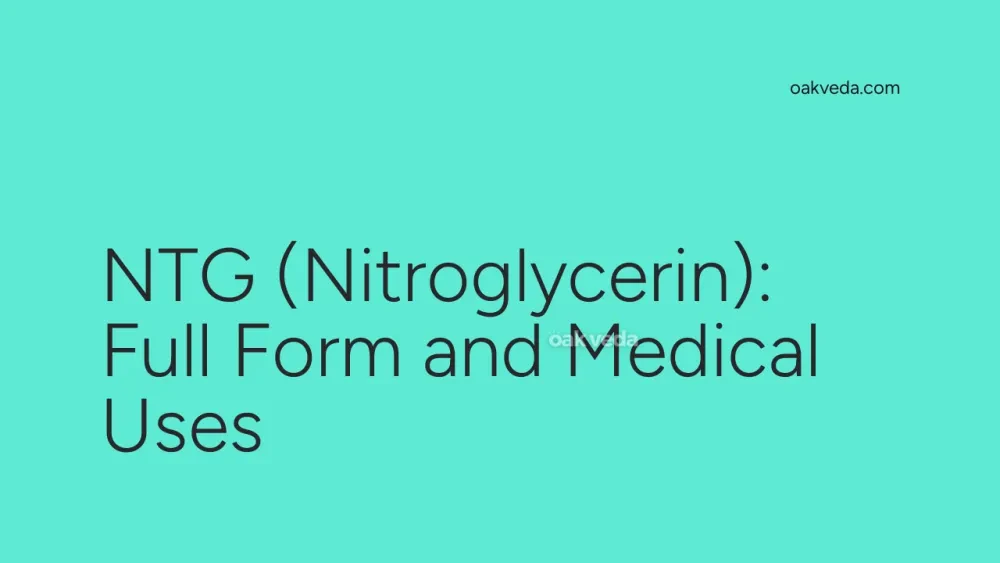
What is the Full Form of NTG?
NTG is the abbreviated form of Nitroglycerin, a powerful chemical compound with diverse applications in medicine and industry. In the medical field, NTG is primarily used as a vasodilator to treat various heart conditions, including angina and heart failure.
What is Nitroglycerin?
Nitroglycerin is a yellow, oily liquid that belongs to the class of drugs known as nitrates. It was first synthesized in 1847 by Italian chemist Ascanio Sobrero. While initially known for its explosive properties, nitroglycerin has found a crucial place in modern medicine due to its ability to dilate blood vessels and improve blood flow to the heart.
Origin and Development of Nitroglycerin
The medical use of nitroglycerin dates back to the late 19th century when William Murrell, an English physician, discovered its potential in treating angina pectoris. Since then, nitroglycerin has undergone significant development and refinement, leading to various formulations and delivery methods for treating cardiovascular conditions.
How does Nitroglycerin work?
Nitroglycerin functions as a potent vasodilator, meaning it relaxes and widens blood vessels. When administered:
- It dilates both arteries and veins, reducing the workload on the heart.
- It increases blood flow to the heart muscle by expanding coronary arteries.
- It decreases the heart's oxygen demand while simultaneously increasing oxygen supply.
This combined effect helps alleviate chest pain and improve overall cardiac function in patients with heart conditions.
Types of Nitroglycerin Medications
Nitroglycerin is available in several forms, each designed for specific uses:
-
Fast-acting forms:
- Sublingual tablets
- Oral sprays
- These are used for immediate relief of angina symptoms
-
Long-acting forms:
- Extended-release capsules
- Transdermal patches
- Ointments
- These are used for long-term prevention of angina attacks
Functions of Nitroglycerin
The primary functions of nitroglycerin in medical applications include:
- Relieving acute angina attacks
- Preventing angina episodes
- Treating chronic heart failure
- Managing hypertensive emergencies
- Controlling blood pressure during surgery
Applications of Nitroglycerin
Nitroglycerin finds extensive use in various medical scenarios:
- Angina management: It provides quick relief from chest pain associated with coronary artery disease.
- Heart failure treatment: It helps reduce the workload on the heart in patients with congestive heart failure.
- Myocardial infarction: It can be used in the early management of heart attacks to improve blood flow to the affected area.
- Hypertensive emergencies: In some cases, it's used to rapidly lower blood pressure in critical situations.
Features of Nitroglycerin
Key features of nitroglycerin as a medication include:
- Rapid onset of action (within 1-3 minutes for sublingual forms)
- Short duration of effect for fast-acting formulations
- Ability to be administered through various routes (oral, sublingual, transdermal)
- Minimal systemic side effects when used as directed
Benefits of Nitroglycerin
The use of nitroglycerin in cardiovascular medicine offers several benefits:
- Quick relief from angina symptoms
- Improved quality of life for patients with chronic heart conditions
- Reduced frequency of angina attacks when used prophylactically
- Decreased hospitalization rates for heart failure patients
- Versatility in administration methods, allowing for personalized treatment plans
Limitations or Challenges of Nitroglycerin Use
Despite its benefits, nitroglycerin use comes with some limitations:
- Side effects: Common side effects include headache, dizziness, and lightheadedness.
- Tolerance: Regular use can lead to tolerance, requiring dose adjustments.
- Contraindications: It should not be used with certain medications, such as phosphodiesterase inhibitors.
- Storage and handling: Some forms are sensitive to light and heat, requiring careful storage.
Future Developments in Nitroglycerin Technology
Research in nitroglycerin technology continues to evolve, focusing on:
- Developing novel delivery systems for more controlled and sustained release
- Exploring combination therapies to enhance efficacy and reduce side effects
- Investigating potential applications in other medical fields, such as wound healing
FAQs on NTG Full Form
-
What is the full form of NTG in medicine? NTG is the abbreviated form of Nitroglycerin, a medication used to treat heart conditions.
-
How quickly does NTG work? Fast-acting forms of NTG, such as sublingual tablets or sprays, typically work within 1-3 minutes.
-
Can NTG be used for long-term treatment? Yes, long-acting forms of NTG, like patches or extended-release capsules, are used for long-term management of heart conditions.
-
Are there any dietary restrictions when using NTG? Alcohol should be avoided while using NTG, as it can enhance the blood pressure-lowering effect and cause dizziness.
-
How should NTG medications be stored? NTG should be stored in a cool, dry place, away from direct light and heat. Some forms may require refrigeration.
In conclusion, NTG, or Nitroglycerin, plays a crucial role in managing various heart conditions. Its ability to rapidly dilate blood vessels makes it an invaluable tool in both acute and chronic cardiovascular care. As research continues, we can expect to see further advancements in NTG technology, potentially expanding its applications and improving patient outcomes.
You may be interested in:

